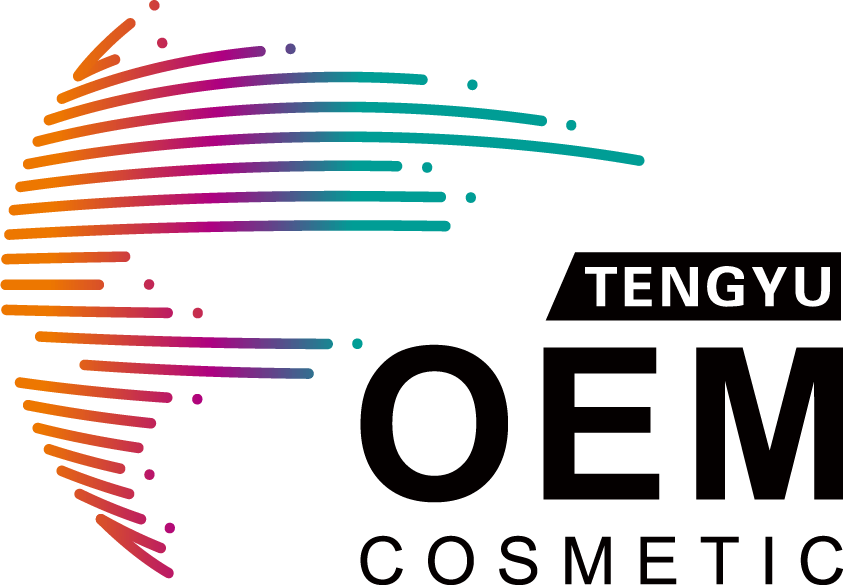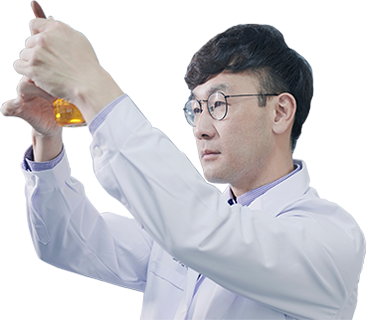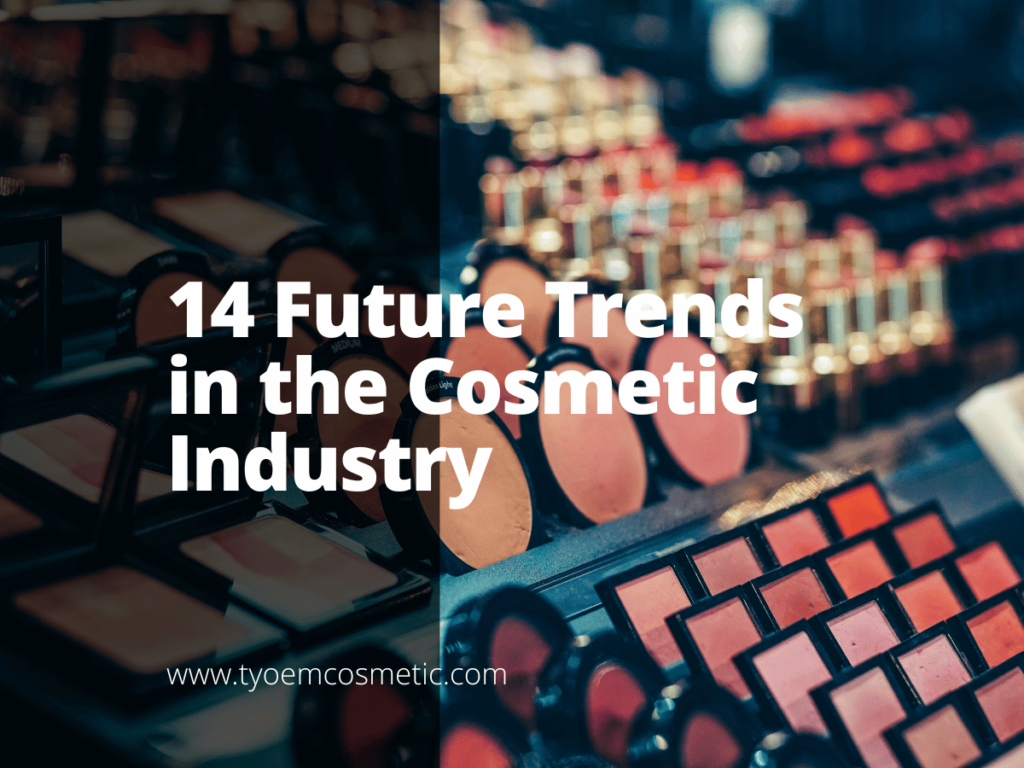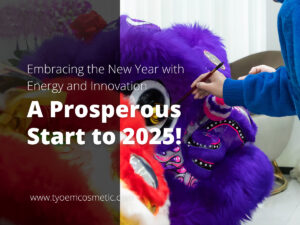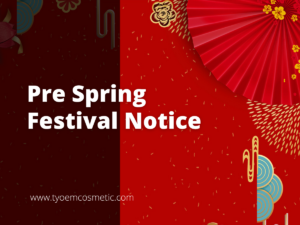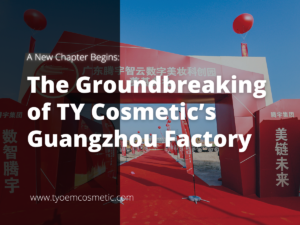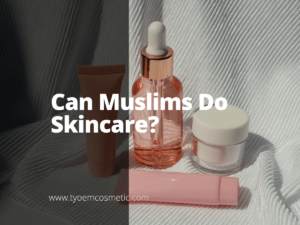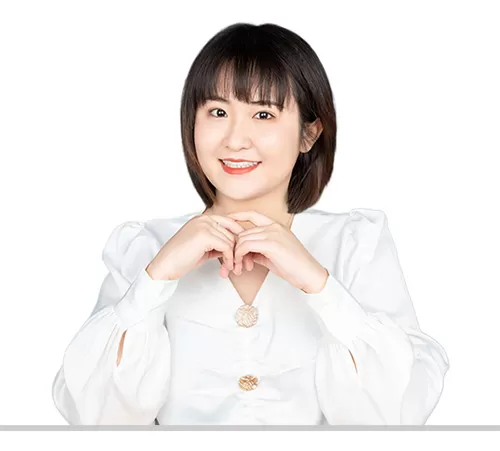We recently delved into an extensive analysis of the cosmetic industry, examining data spanning over five years to answer a pivotal question:
What are the key trends driving the cosmetic industry today and what can we expect in the near future?
We explored various aspects – from market growth and consumer behavior to technological advancements and product innovation.
Collaborating with industry experts and analyzing a wealth of market data, I’m excited to share these findings with you.
And here’s what we uncovered:
Here is a Summary of Our Key Findings:
- Substantial Growth from 2015-2022 with rising consumer spending and expansion in global markets, enhanced by technological advancements.
- COVID-19 Accelerated Digital Adoption and a shift towards personal care and wellness, demonstrating industry resilience and adaptability.
- The luxury segment in beauty is growing faster than mass-market products, especially in premium fragrances and high-end makeup.
- Over 20% of total beauty sales now come from e-commerce, with an anticipated annual growth rate of 12%.
- AI and AR technologies are driving a new era of personalized beauty experiences, significantly impacting customer loyalty.
- Biotech innovations are revolutionizing sustainable beauty, creating eco-friendly alternatives to traditional materials.
- The metaverse and digital platforms are emerging as key channels for brand engagement, particularly among younger consumers.
- Millennials and Gen Z are now the primary consumer groups, emphasizing authenticity, ethics, and sustainability in their purchasing choices.
- A growing trend towards natural and organic products reflects a heightened consumer awareness of health and wellness.
- There’s a significant market expansion in China and North America, with companies exploring new opportunities in Southeast Asia and Latin America.
- Influencers and social media campaigns are having a notable impact on product popularity and brand visibility in the beauty sector.
- In a saturated market, brands that leverage unique formulations or target niche markets are gaining a competitive edge.
- Navigating the complexities of global cosmetic regulations presents challenges but also opportunities for brands focusing on clean beauty.
- Technology adoption and targeting emerging markets like the Middle East and India represent significant opportunities for growth.
#1 Cosmetic Industry’s Explosive Growth Since 2015
Since 2015, the beauty world has been booming. Big sales, global expansion, tech innovations – it’s all happening.
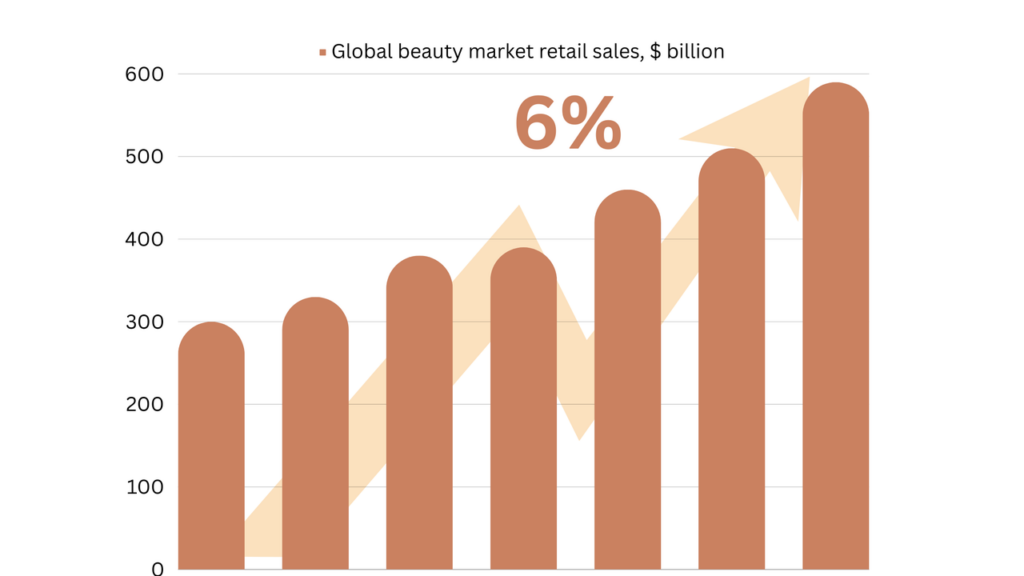
Come 2022, the industry hit $430 billion in revenue. That’s in a year when economies were shaky.
Why? The pandemic.
It changed shopping habits – more online buys, more wellness products.
The industry didn’t just cope; it soared.
And the future? It’s looking bright.
By 2027, the industry is set to reach about $580 billion.
That’s a 6% growth per year.
The reason? Tech getting smarter, people’s tastes evolving, and yes, the global middle class is getting bigger. They’re spending more on beauty than ever.
It’s not just selling lipstick and lotions. It’s catching the wave of changes – from the pandemic to new consumer groups.
Key Takeaway: Since 2015, the beauty industry’s rise to $430 billion showcases not just growth, but a complete market evolution in response to global shifts and consumer habits.
#2 Pandemic Accelerated Digital and Wellness Trends.
The pandemic has been a game-changer for the beauty industry, igniting a significant shift towards digital engagement and a heightened focus on wellness.
When the pandemic hit, beauty brands were quick to pivot online, innovating with virtual try-ons and digital skin consultations.
This digital shift wasn’t just afor temporary; it became the industry’s new standard.
Now, the majority of beauty discovery and shopping occur online, a trend underscored by the report’s findings. In 2022 alone, beauty e-commerce accounted for over 20% of total sales, with projections indicating continued growth.
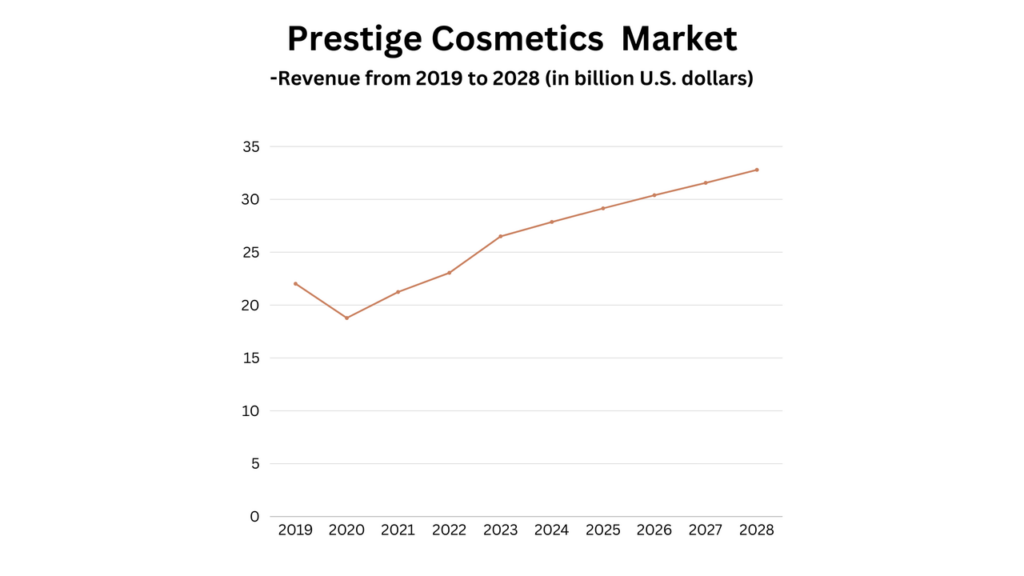
Additionally, the wellness trend has taken the beauty world by storm.
Consumers are increasingly drawn to products that promote not just external beauty but also internal well-being. The report echoes this, showing a surge in demand for natural ingredients and self-care products.
This wellness shift is not just a fleeting trend; it represents a fundamental change in lifestyle and consumer values.
Key Takeaway: The pandemic sparked a significant shift towards digital beauty engagement and a surge in wellness-focused products, as shown by the marked increase in online interactions and sales of health-centric beauty items.
#3 Luxury Products Outperforming Mass Market.
The pandemic not only changed shopping habits but also shifted consumer preferences towards luxury beauty products.
Luxury beauty is booming.
From 2022 to 2027, it’s growing at 8% annually, outpacing mass market products’ 5%.
Consumers are choosing value over volume. Luxury items like premium fragrances and high-end makeup are seeing a sales surge.
Why This Shift? The pandemic shifted focus to self-care and satisfaction.
Luxury products, offering quality and exclusivity, have become symbols of self-expression.
The luxury beauty market is on a steep rise.
By 2027, expect a significant boost, driven by a growing love for premium experiences.
Key Takeaway: This trend indicates a profound shift in consumer behavior, with a leaning towards luxury beauty products that offer not just quality but also an enhanced sense of self-care and personal luxury.
#4 E-commerce Making Over 20% of Sales.
The e-commerce boom has revolutionized the beauty industry since 2015.
It’s not just a growth story; it’s a revolution.
E-commerce has captured over 20% of the beauty industry’s sales from 2015 – 2022, changing the game entirely.
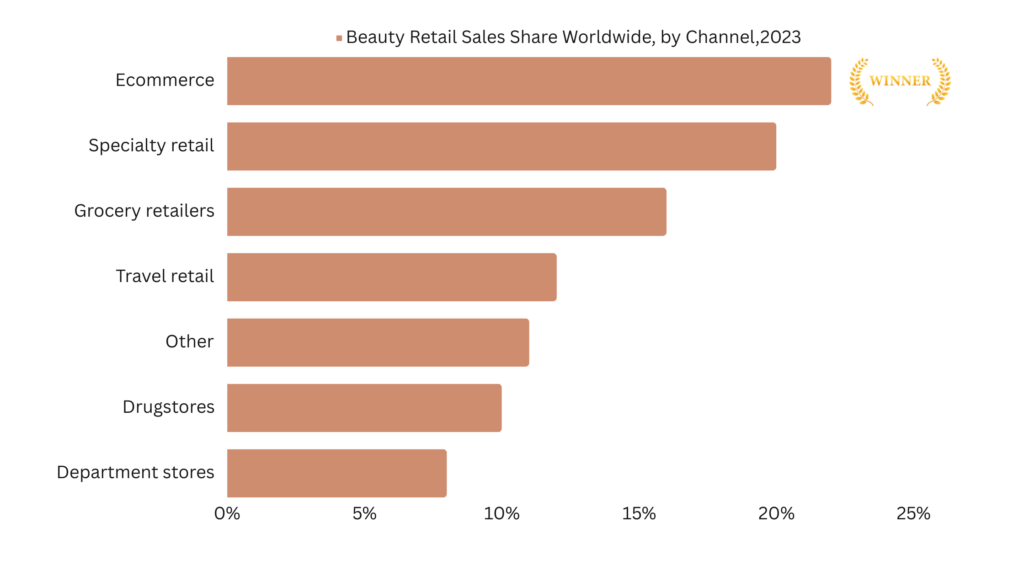
But it’s not stopping there. The future looks even more digital.
The reason? Projections suggest e-commerce will continue to expand its market share, becoming an even bigger player in the beauty industry.
It’s not just a trend; it’s the future of shopping.
Key Takeaway: This trend reveals e-commerce as a transformative force in the beauty industry, reshaping retail dynamics significantly.
#5 Personalization Driven by AI and AR Technologies.
AI and AR are revolutionizing the beauty industry, far beyond just shopping. These technologies are at the forefront of creating unique, personalized experiences for consumers.
AI is redefining the shopping experience in beauty. It’s moving beyond guesswork to accurately predict and suggest products that consumers will love.
Brands like TY Cosmetic are utilizing AI for personalized skin diagnostics, exemplifying the impact of this technology.
AR transformed the way consumers interact with beauty products.
Virtual try-ons have become a significant part of the online shopping experience, allowing consumers to see products on themselves before making a purchase.
Here’s a fact – 45% of customers are saying yes to brands with AI and AR.
This statistic underlines the growing consumer preference for these technologies in their shopping journey.
Key Takeaway: AI and AR are driving personalized shopping experiences, these technologies are crucial in catering to the evolving needs and preferences of modern consumers.
#6 Biotech Innovations Fostering Sustainable Beauty.
The beauty industry is witnessing a green revolution, with biotech leading the charge. This isn’t just about innovation; it’s a fundamental shift towards sustainable beauty practices.
Biotech is making waves with lab-grown ingredients, offering sustainable and eco-friendly alternatives. These advances are in response to consumers’ increasing preference for responsible beauty solutions.
The movement towards ‘clean’ beauty is gaining momentum.
In 2022, a significant 64% of consumers reported that sustainability is very important when considering the purchase of a beauty product (Global Cosmetic Industry).
The beauty industry’s investment in sustainability is a clear sign of its commitment to the future.
The shift towards sustainable product lines is underscored by increased investments from major industry players. Either supporting emerging eco-conscious brands or expanding their sustainable offerings.
Key Takeaway: Biotech is the cornerstone of the beauty industry’s shift towards sustainability. It’s driving significant changes in response to the growing demand for clean and eco-conscious beauty products.
#7 Metaverse Becoming a New Engagement Platform.
The metaverse is redefining engagement in the beauty industry, offering a blend of innovation and interactivity that’s changing the game.
Think of it as beauty’s new virtual world. Here, beauty brands like Ty Cosmetic are offering virtual try-ons and digital consultations, creating experiences that go beyond traditional shopping.
Brands are targeting the metaverse to connect with younger audiences.
It’s not just about sales; it’s about crafting memorable, interactive brand experiences.
The metaverse isn’t just attracting attention; it’s drawing in a significant market share.
Research from Snipp indicates that up to 60% of millennials are making purchases in virtual worlds. It shows readiness to embrace virtual shopping platforms marks a significant shift in consumer behavior.
With each social media evolution, beauty brands have adapted. The metaverse is the latest and possibly the most transformative stage.
The metaverse is opening a new realm of possibilities for beauty brands.
It’s a move from just being online to being fully interactive, a shift that’s aligning perfectly with consumer expectations and technological advancements.
Key Takeaway: The metaverse is rapidly becoming a core engagement platform in the beauty industry, particularly for Millennials. It’s a space where interactivity and innovative experiences converge, aligning with the industry’s digital evolution and changing consumer expectations.
#8 Millennials and Gen Z Prioritizing Ethical Beauty.
Millennials and Gen Z are reshaping the beauty industry. They’re not just buying products; they’re choosing values.
For these generations, brand values are crucial.
They’re looking for brands that champion sustainability, diversity, and inclusivity.
A 2020 study by Kadence reveals that 66% of Gen Zers will pay more for sustainable products, and 73% for ethically sourced ones. This data underscores their commitment to ethical consumption.
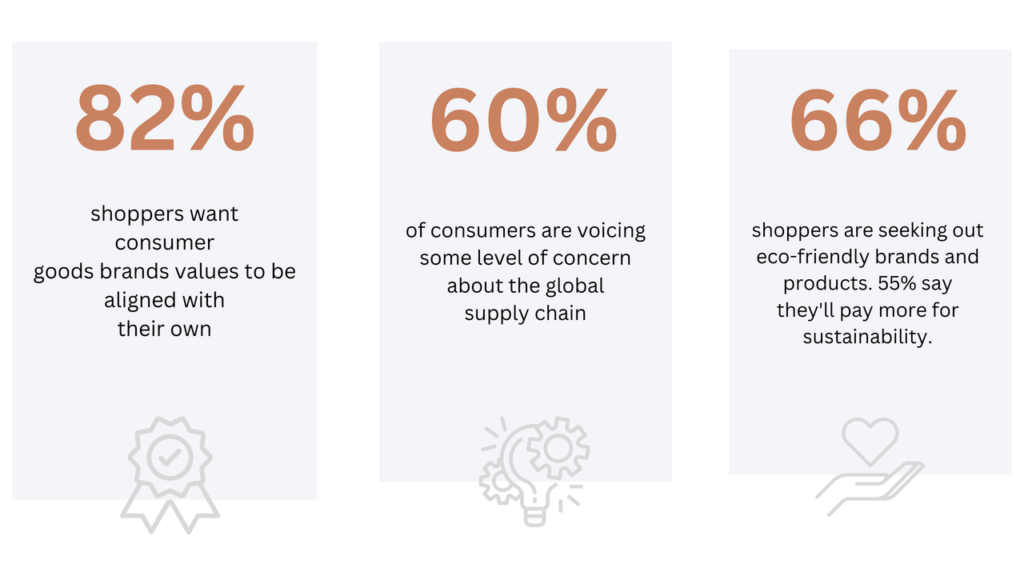
Millennials and Gen Z are setting a new benchmark in the beauty industry: clean and sustainable are the new norms.
They demand transparency in ingredients and are inclined to invest more in products that are sustainable and ethically produced.
The response from the beauty market is clear, with a growing preference among these consumers for brands that embody these values.
Key Takeaway: Ethical beauty isn’t a choice for Millennials and Gen Z; it’s a necessity. They’re steering the industry towards greater transparency, sustainability, and ethical practices.
#9 Surge in Natural and Organic Product Demand.
Natural and organic are more than just labels in beauty now. They’re what people want.
Today’s beauty consumers prioritize transparent, eco-friendly products.
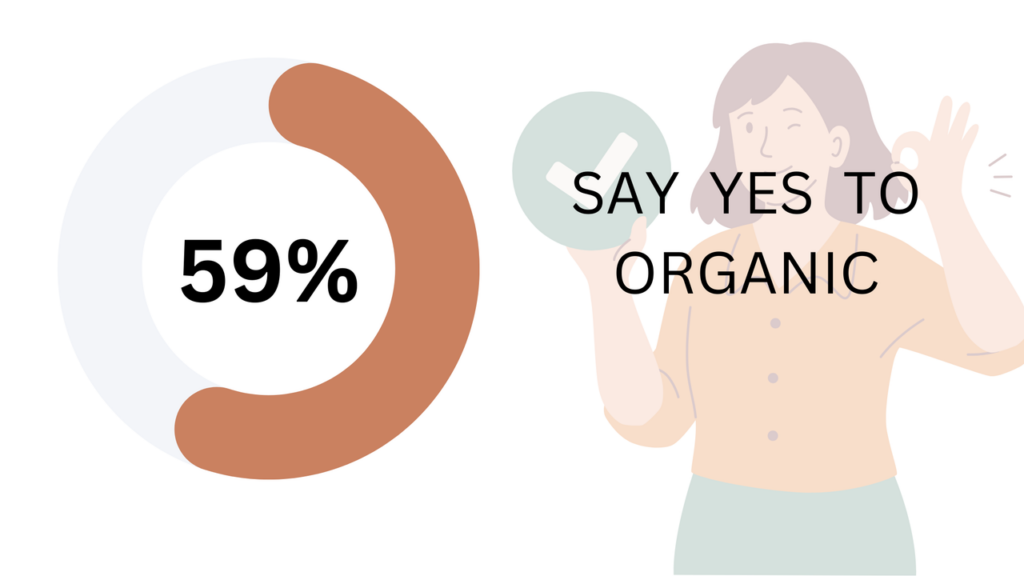
It’s clear – customers are choosing health and wellness. They’re looking for products with transparent, natural ingredient lists.
And the numbers? They’re telling.
Exploding Topics revealed 59% of people are influenced by products that are described as natural and organic.
Why is this trend so big? This isn’t just a trend; it’s a shift in awareness.
People are more health-conscious and eco-minded.
They’re not just buying beauty products; they’re making a statement about their values.
Key Takeaway: The growing demand for natural and organic beauty products marks a significant industry shift. It reflects a move towards more ethical, transparent, and sustainable practices in beauty, now a key consumer expectation.
#10 Significant Growth in China and North America.
The beauty market’s soaring in China and North America. It’s not just growth; it’s a whole new level.
Big news! The Chinese beauty market is on a swift rise, projected to reach $96 billion by 2027. This significant increase is driven by an expanding middle class and a growing demand for premium beauty products.

It is pleasing that North America’s beauty market is also seeing robust growth reaching $114 billion by 2027. This reflects the region’s diverse consumer base and adaptability to new trends.
The distinct growth patterns in these regions illustrate the diversity of the global beauty market.
Beauty giants are strategically expanding into new markets, with a focus on regions like Southeast Asia and Latin America. Highlighting the importance of a global footprint in the beauty industry.
Key Takeaway: The dynamic growth in China and North America’s beauty markets showcases the varied and vibrant nature of the global beauty industry.
#11 Social Media Influences Product Popularity.
Social media has become a pivotal platform in the beauty industry, it’s impact extends beyond mere advertising; it shapes consumer perceptions and purchasing decisions.
Today, a product’s success is increasingly tied to its social media presence.
Platforms like Instagram, TikTok, and YouTube are not just for sharing content; they’re powerful tools that influence what consumers buy.
So how does it help? Brands leveraging influencer marketing often see a dramatic increase in interest and sales for featured products.

Influencers across social media platforms are setting beauty trends. Their power to influence is evident, as they guide consumer preferences and dictate market trends.
A staggering 89% of TikTok users have bought a beauty product after seeing it on the app, according to Exploding Topics. This statistic underscores the platform’s significant influence on consumer buying behavior.
Key Takeaway: Social media, especially TikTok, has become pivotal in driving beauty product popularity. It’s a digital era where influencers and viral content can make or break beauty trends.
#12 Niche Markets Offering Competitive Edge.
In the crowded beauty industry, niche markets are making waves. It’s where indie brands shine, offering something different, something more targeted.
Niche brands are successfully addressing specific needs, from organic skincare to personalized beauty products.
Aligning with consumer expectations, McKinsey reported that 71% of today’s consumers expect personalized experiences when they shop.
Niche brands, with their tailored offerings, are perfectly positioned to meet these expectations.
Storytelling in niche beauty goes beyond selling a product; it’s about forging a connection.
Niche brands are creating loyal customer bases through authentic, relatable narratives.
By focusing on particular consumer preferences, niche brands are forging their paths in the competitive beauty market.
Key Takeaway: Niche beauty markets are changing the game, bringing innovation, authenticity, and personalization to the forefront.
#13 Compliance with Global Regulations Key for Expansion.
For beauty brands, global expansion hinges on navigating a complex web of international regulations.
Different countries, different rules. Brands must master this regulatory landscape to tap into international markets.
Meeting global standards isn’t just about legality; it’s about earning consumer trust.
In the beauty industry, regulatory compliance is a path to differentiation and consumer confidence.
Brands that successfully navigate these regulations are often viewed as more credible and trustworthy.
This adherence, especially in areas like sustainability and clean beauty, aligns with what consumers are increasingly demanding: transparency and ethical production.
Key Takeaway: Effective compliance with global cosmetic regulations is crucial for beauty brands looking to expand. It’s not just about opening new markets; it’s about building trust and standing out in the global beauty arena.
#14 Technology and New Markets Driving Future Growth.
The beauty industry is witnessing a tech revolution, transforming not just products but the entire consumer experience.
Alright, so you’ve got AI, AR, and all that cool tech stuff.
It sounds fancy, but here’s what it really means: shopping for beauty is getting a major upgrade.
Like, AR try-ons? They’ve jumped up in use by 40% recently.
It’s like trying on makeup without leaving your couch.
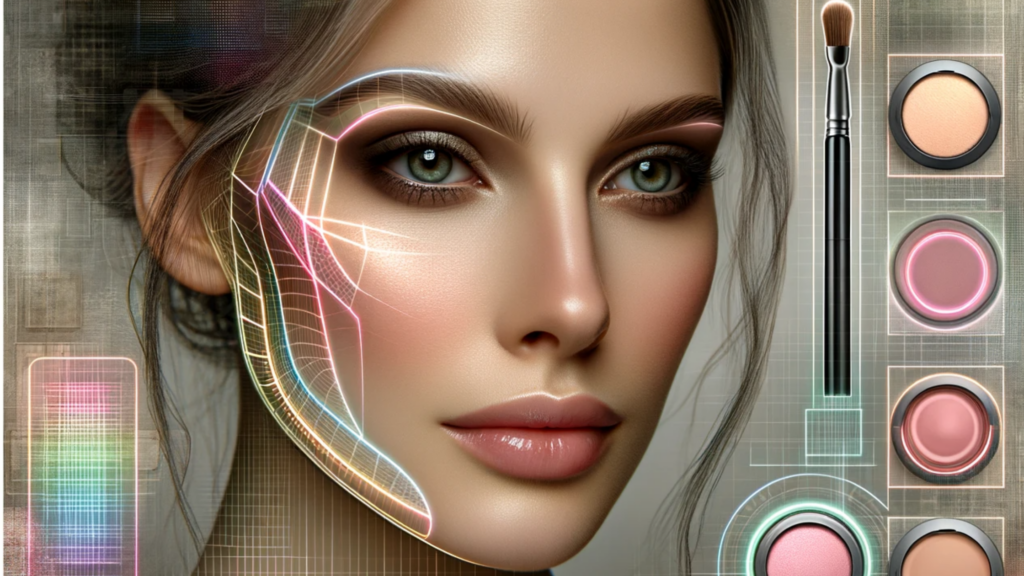
Expanding into new geographic regions is opening up vast opportunities for growth in the beauty sector.
Beauty brands are eyeing untapped markets in regions like the Middle East and India, where an expanding middle class is driving increased spending on beauty products.
Successfully entering these markets involves understanding and catering to local consumer preferences, a strategy that can lead to substantial growth.
Key Takeaway: The beauty industry’s future is shaped by technological advancements and the exploration of new markets. Embracing AI and AR technologies and expanding into emerging regions are key to staying ahead in a rapidly evolving market.
Conclusion
In this analysis, we’ve unveiled the key shifts transforming the beauty landscape, from e-commerce’s rise to sustainability and niche markets. These trends are paving the way for brands to innovate and connect with consumers on a deeper level.
If you’re a cosmetic shop owner seeking to navigate these trends, TY Cosmetic merges tradition with innovation. Contact us to explore the future of beauty and elevate your offerings.
